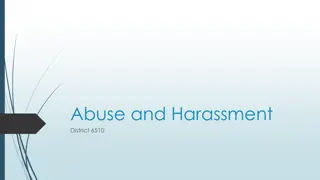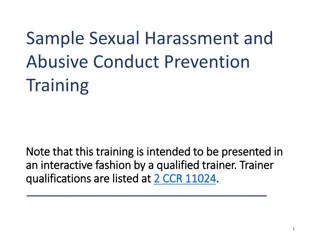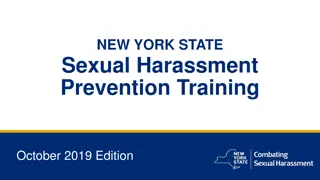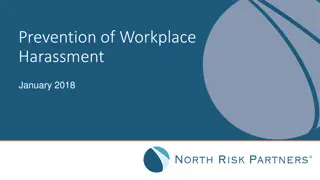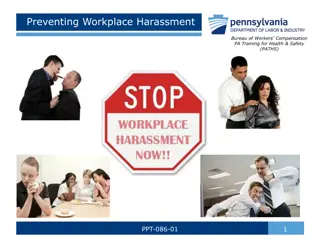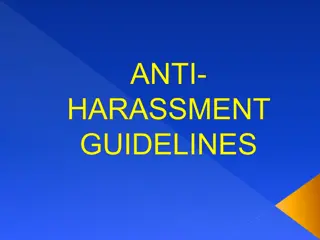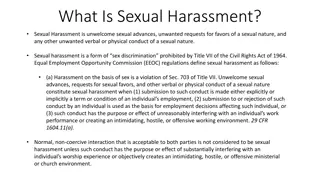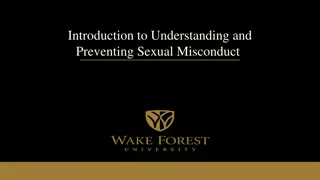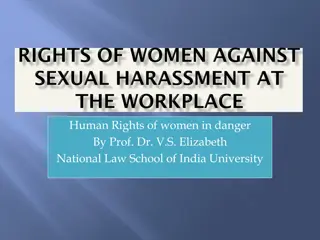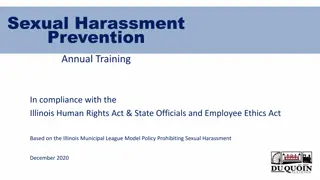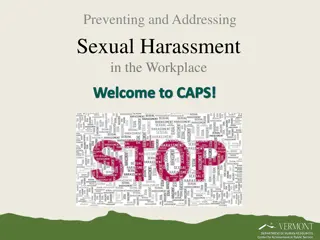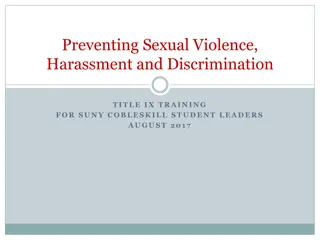Recognizing and Preventing Sexual Harassment: Supervisor Training Program
This sexual harassment prevention training for supervisors covers the importance of recognizing, responding to, and preventing sexual harassment in the workplace. It outlines what constitutes sexual harassment, the two forms of harassment (quid pro quo and hostile work environment), and the legal obligations and responsibilities of supervisors in preventing and addressing such behavior.
Download Presentation

Please find below an Image/Link to download the presentation.
The content on the website is provided AS IS for your information and personal use only. It may not be sold, licensed, or shared on other websites without obtaining consent from the author.If you encounter any issues during the download, it is possible that the publisher has removed the file from their server.
You are allowed to download the files provided on this website for personal or commercial use, subject to the condition that they are used lawfully. All files are the property of their respective owners.
The content on the website is provided AS IS for your information and personal use only. It may not be sold, licensed, or shared on other websites without obtaining consent from the author.
E N D
Presentation Transcript
Sexual Harassment Prevention Training for Supervisors
Sexual Harassment Prevention Training for Supervisors WELCOME! 2
Introduction Sexual harassment training is not required under federal law. However, many states have enacted legislation specifically requiring sexual harassment training. Even if not required in a state, the Supreme Court s landmark decisions in the Faragher and Ellerth sexual harassment cases, subsequent court decisions and Equal Employment Opportunity Commission (EEOC) guidelines make it clear that sexual harassment training is essential. As supervisors on the front line, it is essential that you know how to recognize sexual harassment and how to respond and prevent it. 3
Agenda What is sexual harassment? Why it is important to prevent sexual harassment in our workplace? Sexual harassment judgments. Retaliation. Our policy and procedure on sexual harassment. Your responsibilities as supervisors. 4
What is Sexual Harassment? Unwelcome sexual advances. Requests for sexual favors. Other verbal, written, electronic or physical conduct of a sexual nature that affects an individual s employment, unreasonably interferes with his or her work performance, or creates an intimidating, hostile or offensive work environment. 5
What is Sexual Harassment? (cont.) The two forms of sexual harassment are: Quid pro quo (Latin for this for that or something for something ). Hostile work environment. 6
What is Sexual Harassment? (Quid Pro Quo) Quid Pro Quo: Tangible employment action against the victim. Involves monetary loss or change in job. Example: Yvette receives a smaller performance-based pay increase than other employees with similar performance because she refused to go on a date with her supervisor, Marcus. 7
What is Sexual Harassment? (Hostile Work Environment) Hostile Work Environment: Speech or conduct that is severe and/or pervasive enough to create an abusive or hostile work environment. Example: Max is leering at and intentionally brushing against Vanessa. 8
What is Sexual Harassment? (Hostile Work Environment) Hostile Work Environment (cont.) In addition to speech and/or conduct, hostile work environment covers explicit or suggestive items that are e-mailed, texted, electronically provided or displayed in the workplace that interfere with job performance or that create an abusive or hostile work environment. Example: Maria texts and instant messages her co-workers with sexually explicit jokes and pictures. 9
What is Sexual Harassment? (cont.) Who can commit sexual harassment? Employees at all levels. Customers or vendors. Members of the same sex or opposite sex. Who can be a victim of sexual harassment? Individual or individuals targeted by statements or actions. Bystanders or witnesses not directly targeted. 10
Why It Is Important to Prevent Sexual Harassment in Our Workplace? Sexual harassment harms us all. The most important part of our corporate values is to ensure all employees are treated with respect and dignity. Engaging in, condoning or not reporting sexual harassment is in direct conflict with our values. We want to remain in compliance with Title VII of the Civil Rights Act, which prohibits sex discrimination (including sexual orientation and gender identity or expression). We want to remain in compliance with similar state civil rights laws and fair employment laws. 12
Why It Is Important to Prevent Sexual Harassment in Our Workplace? (cont.) Liability for the employer may be under federal or state law or civil litigation. The company is always responsible for harassment by a supervisor that results in a tangible employment action such as a hiring, firing, promotion, demotion and changes in pay, benefits or work duties. This is considered quid pro quo sexual harassment. 13
Why It Is Important to Prevent Sexual Harassment in Our Workplace? (cont.) If the harassment does not result in a tangible employment action, the employer may still be liable unless it proves both of the following: It exercised reasonable care to prevent and promptly correct any harassment. The employee unreasonably failed to take advantage of the company s complaint or corrective policy and procedures. 14
Why It Is Important to Prevent Sexual Harassment in Our Workplace? (cont.) Individual Liability Many state nondiscrimination laws define employer to include individual supervisors, managers or officials. Increasingly these company individuals face an individual liability risk because many suits contain state law claims. 15
Our Policy and Procedure on Sexual Harassment 17
Sexual Harassment Judgments EEOC remedies for a sexual harassment or sex discrimination complaint may include: Job reinstatement. Back pay and benefits the victim should have earned. Compensatory damages (paying for out-of-pocket expenses). Punitive damages. Liquidated damages (in sex-based wage discrimination) equal to the amount of back pay awarded to the victim. 19
Retaliation Retaliation is an adverse action taken against an employee because he or she complained of harassment or discrimination or participated in an investigation. Adverse action includes demotion, discipline, termination, salary reduction, negative performance appraisal, change in job duties or shift assignment. 21
Retaliation (cont.) Anti-discrimination laws prohibit employers from taking adverse action against employees for asserting their rights. When an employee complains of sexual harassment to you or to others in this company or to a government agency, you must not take any action that the employee may view as punishment or retaliation for filing the complaint. 22
Retaliation (cont.) To succeed in a retaliation claim, an employee must prove the following: That he or she engaged in a protected activity, such as complaining of sexual harassment. That he or she suffered an adverse employment action, such as demotion or termination. That the protected activity and adverse action are linked. 23
Retaliation (cont.) To avoid charges of retaliation: Document the reason for any adverse employment against an employee. Make sure that the documentation shows no discriminatory reason for the adverse action. Do not take any adverse action against an employee who has complained of sexual harassment without discussing with and obtaining approval from HR. 24
Your Responsibilities as Supervisors Know and comply with our policy and procedures. Immediately report to human resources any complaint that you receive from your employees or incidents that you witness involving other supervisors or employees. 26
Your Responsibilities as Supervisors (cont.) When handling sexual harassment complaints from your employees: Demonstrate your willingness to hear and objectively discuss complaints. Inform the employee that you must report all complaints to HR. Tell the employee that confidentiality will be respected as much as possible but cannot be ensured in order to investigate fully and properly. 27
Your Responsibilities as Supervisors (cont.) Do not object if an employee prefers to or actually does bypass the standard chain of command. Do not engage in retaliation against an employee who complains of sexual harassment or participates in an investigation. Be available for interviews and provide as much information as possible. Allow employees to be available for interviews. 28
Your Responsibilities as Supervisors (cont.) Once an investigation has been completed, if disciplinary action is to be taken, work with human resources to make sure that: The victim is not adversely affected. The sexual harassment stops and does not recur. 29
Summary Sexual harassment is unwelcome sexual advances, requests for sexual favors and other verbal or physical conduct of a sexual nature that affects an individual s employment, unreasonably interferes with his or her work performance, or creates an intimidating, hostile or offensive work environment. 31
Summary (cont.) It is important to prevent sexual harassment in our workplace because it harms us all. It conflicts with our corporate value that all employees are treated with respect and dignity. Sexual harassment and retaliating against an employee who complains of sexual harassment are illegal under federal and state laws. 32
Summary (cont.) The two forms of sexual harassment are quid pro quo and hostile work environment. Retaliation is taking adverse action against an employee who has complained of sexual harassment. It is just as illegal as sexual harassment and is strictly prohibited in our company. 33
Summary (cont.) Your responsibilities as supervisors include: Complying with our policy and procedures. Immediately reporting complaints you receive or incidents you witness to HR. Handling complaints from your employees in accordance with our policy and procedures. Never retaliating against an employee who complains of sexual harassment. Assisting with investigations and disciplinary action. Ensuring that victims are not adversely affected. Making sure that sexual harassment stops and does not recur. 34
Training Evaluation Please complete the training evaluation sheet included in the handouts. Thank you for your interest and attention! 36





